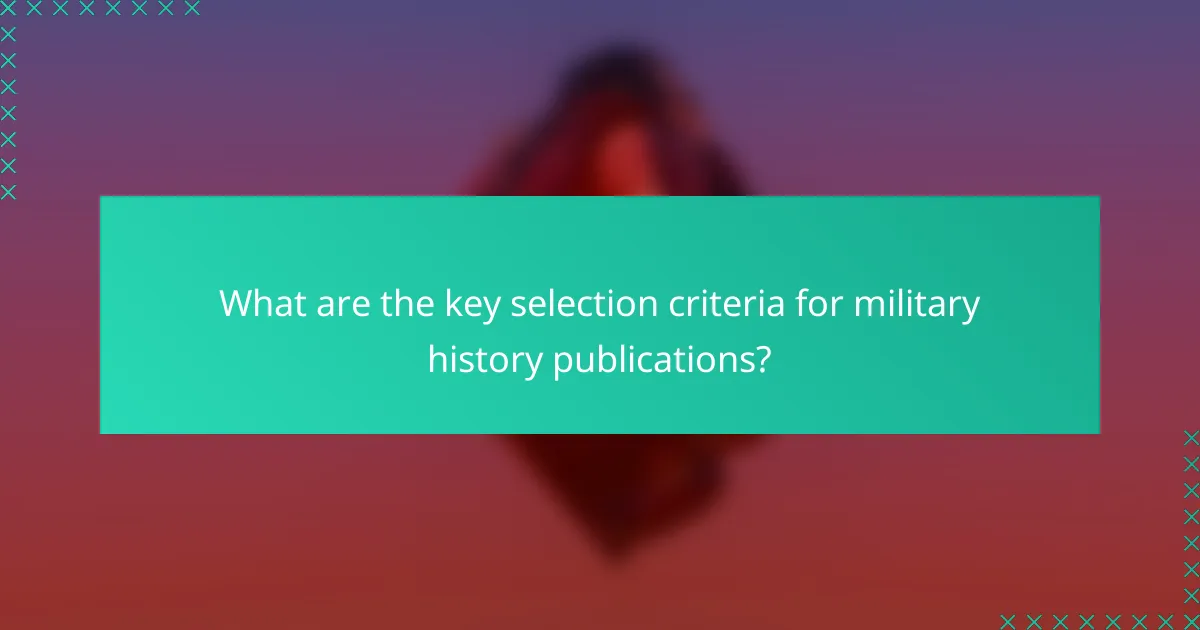When selecting military history publications, it is essential to consider criteria such as author credibility, publication reputation, research methodology, source reliability, and peer reviews. These factors play a crucial role in ensuring the quality and accuracy of the information presented. Additionally, the regional context can influence the narratives and topics emphasized in military history literature, reflecting diverse cultural perspectives and historical events.

What are the key selection criteria for military history publications?
The key selection criteria for military history publications include author credibility, publication reputation, research methodology, source reliability, and peer reviews. Evaluating these factors helps ensure the quality and accuracy of the information presented in military history literature.
Author credibility
Author credibility is crucial in military history publications, as it reflects the author’s expertise and background in the field. Look for authors with advanced degrees in history or military studies, as well as a track record of published works in reputable journals or books.
Additionally, consider the author’s affiliations with academic institutions or military organizations, which can further enhance their credibility. An author with firsthand military experience or extensive research in military history can provide valuable insights.
Publication reputation
The reputation of the publication plays a significant role in assessing military history works. Established academic presses and well-known historical journals are typically more reliable than self-published works or lesser-known outlets.
Check for the publication’s impact factor or citation index, which can indicate its influence in the field. A reputable publication often has a rigorous editorial process, ensuring that the content meets high academic standards.
Research methodology
Research methodology refers to the techniques and approaches used by the author to gather and analyze information. A strong publication should clearly outline its methodology, including the types of sources consulted and the analytical frameworks applied.
Look for works that utilize a mix of primary and secondary sources, as this can provide a more comprehensive view of historical events. Transparency in methodology allows readers to assess the validity of the conclusions drawn.
Source reliability
Source reliability is essential for ensuring the accuracy of the information presented in military history publications. Authors should use credible primary sources, such as official military documents, personal letters, and eyewitness accounts, alongside reputable secondary sources.
Evaluate the sources cited in the publication; they should come from respected historians, archives, or institutions. Be cautious of works that rely heavily on anecdotal evidence or unverified claims.
Peer reviews
Peer reviews are a critical component of academic publishing, providing an additional layer of scrutiny for military history publications. Works that have undergone peer review are typically more reliable, as they have been evaluated by experts in the field for quality and accuracy.
When selecting military history publications, prioritize those that have been peer-reviewed, as this process helps ensure that the research meets established academic standards and contributes meaningfully to the field.

How do military history publications differ by region?
Military history publications vary significantly by region, influenced by cultural perspectives, historical events, and available resources. Each region emphasizes different aspects of military history, shaping how narratives are constructed and what topics are prioritized.
North American military history
In North America, military history publications often focus on the Revolutionary War, the Civil War, and World War II, reflecting the region’s significant conflicts. Authors typically emphasize personal narratives, battles, and the impact of military actions on society. Popular formats include detailed biographies, tactical analyses, and thematic studies.
Research in this area often utilizes primary sources such as letters, diaries, and official military documents. A common pitfall is the over-reliance on a single perspective, so it’s crucial to incorporate diverse viewpoints to provide a more balanced account.
European military history
European military history publications cover a broad range of conflicts, from the Napoleonic Wars to World War I and II, with a strong emphasis on strategic and political implications. The region’s rich military tradition leads to extensive scholarly work, often grounded in archival research and interdisciplinary approaches.
Publications may include comprehensive histories, analyses of military strategies, and examinations of the socio-political context surrounding conflicts. Researchers should be cautious of national biases and strive for a nuanced understanding of events that shaped Europe’s military landscape.
Asian military history
Asian military history publications often highlight ancient conflicts, colonial struggles, and modern warfare, reflecting the continent’s diverse historical experiences. Key areas of focus include the Mongol invasions, the Opium Wars, and the Vietnam War, with publications frequently examining the interplay between military and cultural factors.
Research in this field may involve a mix of traditional historical analysis and contemporary military studies. It’s essential to consider regional narratives and avoid imposing Western frameworks, ensuring that local contexts and perspectives are accurately represented in the scholarship.

What are the most reputable military history publishers?
Reputable military history publishers are known for their rigorous editorial standards and contributions to the field. These publishers often produce scholarly works that are widely respected among historians and military professionals.
Oxford University Press
Oxford University Press is a leading publisher in military history, known for its comprehensive range of academic titles. Their books often cover various aspects of military strategy, warfare, and historical analysis, making them a go-to source for researchers and students alike.
When selecting titles from Oxford, consider their focus on peer-reviewed content, which ensures high-quality scholarship. Look for series such as “Oxford Studies in Modern European History” that specifically address military topics.
Cambridge University Press
Cambridge University Press offers a diverse array of military history publications, emphasizing both classic and contemporary studies. Their works often explore the social, political, and cultural implications of military events, providing a well-rounded perspective.
Pay attention to their “Cambridge Military Histories” series, which presents in-depth analyses of significant conflicts. The publisher’s commitment to academic rigor makes it a reliable choice for serious researchers.
University of Nebraska Press
The University of Nebraska Press specializes in military history, particularly focusing on American conflicts and the experiences of soldiers. Their titles often highlight personal narratives and regional studies, offering unique insights into military life.
Consider their “Modern War Studies” series, which features both historical and contemporary military issues. This publisher is particularly valuable for those interested in the intersection of military history and cultural studies.

What types of military history publications are available?
Military history publications encompass a variety of formats, each serving different research needs. The main types include academic journals, monographs, and documentary collections, each offering unique insights and methodologies for studying military history.
Academic journals
Academic journals are periodicals that publish peer-reviewed articles on military history topics. They often feature original research, theoretical discussions, and reviews of existing literature, making them essential for scholars seeking current trends and debates in the field.
When selecting journals, consider their impact factor and the reputation of the editorial board. Notable journals include the “Journal of Military History” and “War in History,” which provide rigorous analyses and diverse perspectives.
Monographs
Monographs are detailed, book-length studies focused on specific military events, figures, or themes. They typically provide in-depth analysis and are often authored by experts in the field, making them valuable resources for comprehensive understanding.
When choosing monographs, look for those published by reputable academic presses, as they usually undergo stringent editorial processes. Examples include works like “The Face of Battle” by John Keegan, which offers critical insights into the experiences of soldiers in combat.
Documentary collections
Documentary collections compile primary source materials related to military history, such as letters, official reports, and photographs. These collections are crucial for researchers who wish to engage directly with historical documents and gain firsthand perspectives.
Consider collections that provide context and analysis alongside the documents, enhancing their usability. Noteworthy examples include “The Civil War: A Collection of Essential Documents,” which presents a range of materials from that era, allowing for a richer understanding of the conflict.

How to evaluate the impact of military history publications?
Evaluating the impact of military history publications involves assessing their scholarly influence, relevance to policy, and reception by the public. These criteria help determine the significance and effectiveness of the work in shaping understanding and discourse around military events and theories.
Citation analysis
Citation analysis measures how often a publication is referenced in other scholarly works, indicating its influence within the academic community. A high citation count typically suggests that the work is considered authoritative or foundational in its field. Tools like Google Scholar or Web of Science can provide citation metrics to assist in this evaluation.
When analyzing citations, consider the context in which the work is cited. Are authors using it to support their arguments, or is it being critiqued? This context can provide deeper insights into the publication’s impact.
Influence on policy
The influence of military history publications on policy can be gauged by examining whether they have been referenced in government documents, military training materials, or strategic reports. Publications that shape policy discussions often do so by providing historical precedents or lessons learned that inform current military strategies.
To assess this influence, look for instances where military leaders or policymakers cite specific works in speeches or official statements. This direct connection can highlight the practical implications of historical analysis on contemporary military decision-making.
Public reception
Public reception of military history publications can be evaluated through reviews in popular media, sales figures, and reader engagement on platforms like social media or forums. A book that resonates with a broader audience may indicate its relevance and accessibility beyond academic circles.
Consider the diversity of feedback as well. Positive reviews from both historians and general readers can signal a well-rounded impact, while critiques may reveal areas of contention or disagreement within the field. Tracking these responses can provide a clearer picture of the publication’s overall significance.

What are emerging trends in military history research?
Emerging trends in military history research include the integration of digital humanities and interdisciplinary approaches. These trends enhance the analysis of military events and their broader societal impacts, allowing researchers to utilize new technologies and methodologies.
Digital humanities integration
Digital humanities integration involves using digital tools and methods to analyze historical military data. This can include text mining, geographic information systems (GIS), and data visualization techniques, which help researchers uncover patterns and insights that traditional methods might miss.
For instance, historians can map battlefields using GIS to visualize troop movements and strategies, providing a clearer understanding of military tactics. Additionally, digital archives allow for broader access to primary sources, enabling a more comprehensive exploration of military history.
To effectively integrate digital humanities, researchers should consider the following: ensure data accuracy, choose appropriate digital tools, and remain aware of the ethical implications of digital scholarship. Collaborating with digital experts can also enhance the quality and impact of research outcomes.


